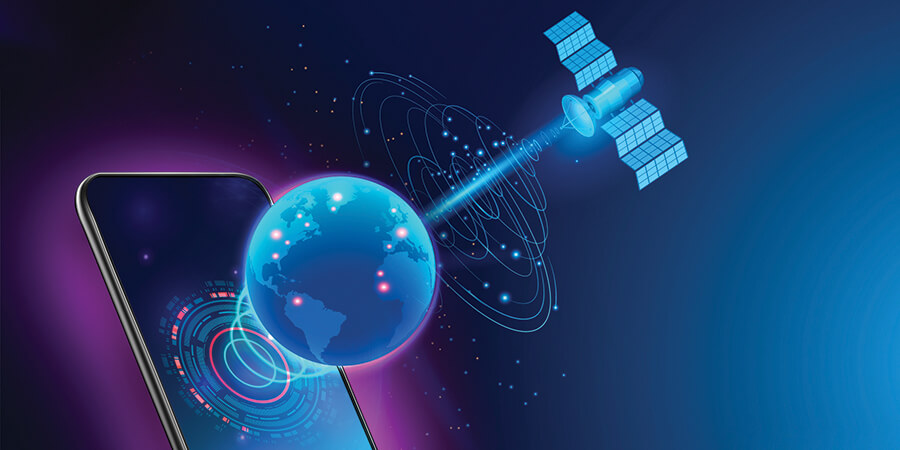Communication has evolved from the ringing of doorbells to the answering of mobile phones. Cellular coverage has been a significant pioneer in the telecommunications industry, greatly simplifying communication. However, with each advancement in this field, new challenges emerge, requiring innovation from global tech leaders to lead the way and introduce groundbreaking ideas. Presently, the primary source of frustration in this domain is the existence of cellular dead zones. The race to address and resolve this issue is intensifying, with a focus on providing the optimal solution.
Direct-to-Cell Satellite: A New Advancement in Cellular Coverage
Unlike traditional cellular networks constrained by terrestrial reach, direct-to-cell satellite technology enables users to access mobile phone connectivity anywhere on Earth, provided they have an unobstructed view of the sky. This innovation allows customers, in most instances, to utilize their existing phones for connectivity even in areas already covered by terrestrial cellular networks.
Initially, the satellite coverage will be limited to text messaging. Nevertheless, there are ongoing plans to extend the services, including voice and data coverage, as well as Internet of Things (IoT) connectivity, by 2025.
It's important to note that this technology is not designed to compete with existing terrestrial cellular networks. While it serves as an excellent solution for locations lacking cellular connectivity, its data transfer speeds are capped at around 7Mb per beam. Consequently, direct-to-cell satellite coverage may not match the performance levels of well-established cellular networks.
Pioneering Direct-to-Cell Satellite Capabilities
Numerous tech leaders are vying to be the first to implement direct-to-cell satellite technology. A recent forerunner in this race is SpaceX— with its launch of Starlink satellites. This initial batch, equipped with direct-to-cell capabilities, specifically targets remote areas worldwide where traditional cell towers are absent, aiming to deliver convenient cellular service to devices in those regions.
T-Mobile is not the sole wireless provider engaged in this groundbreaking initiative. Other carriers, including KDDI in Japan, Optus in Australia, and Rogers Communications in Canada, have also secured partnerships with Starlink to harness the potential of direct-to-cell technology.
Notably, Verizon Wireless is working with Amazon's Project Kuiper to extend coverage to remote areas using low Earth orbit (LEO) satellites.
Furthermore, smartphone manufacturers like Apple are looking at integrating satellite capabilities into their devices, introducing emergency SOS features that utilize satellite connectivity.
Direct-to-Cell Satellite Technology Versus Current Cellular Networks
Cellular networks have evolved into high-speed, high-capacity communication systems, offering seamless multimedia experiences and supporting a wide array of functions beyond entertainment and phone calls. These networks play a crucial role in finance-sensitive transactions, lifesaving emergencies, and mission-critical services like E-911, establishing them as the primary communication lifeline in today's interconnected world. The potential breakdown of a cellular network can lead to severe consequences, including significant economic losses, loss of life in emergencies, and communication disruptions during critical events. Ensuring the accurate functioning of cellular networks is of utmost importance due to their integral role in various aspects of daily life.
In contrast, the advent of direct-to-cell satellite technology aims to address areas lacking terrestrial cellular connectivity without competing with existing networks. Although it provides a valuable solution for connectivity in remote regions, it's essential to acknowledge that its data transfer speeds may not match the efficiency of established terrestrial networks.
Satellite Technology's Role in Global Connectivity
As the world embraces the digital age, studies indicate that approximately 65% of the global population has internet access, primarily facilitated by fiber optics on land, cable infrastructure, or mobile broadband connections. Despite this, over three billion people in remote areas still lack connectivity. The development of satellite technology has emerged as a promising solution to bridge this digital divide.
Since the launch of Sputnik 1 in 1957 (which marked the beginning of satellite technology history), various industries have leveraged satellites to redefine communication and overcome connectivity challenges, especially in remote regions globally. Communication satellites, exemplified by Telstar 1 in 1962, pioneered the transmission of live television broadcasts across the Atlantic, demonstrating satellite technology's potential to connect individuals worldwide.
Satellite internet, transmitted through orbiting satellites, offers an innovative approach to internet connectivity. It eliminates the need for traditional land-based infrastructure, making it invaluable in challenging terrains or remote locations. Geostationary satellites and low Earth orbit (LEO) satellites play pivotal roles in global communication networks, with LEO satellites offering benefits such as lower latency and faster data transfers.
As direct-to-cell satellite technology undergoes continuous evolution and expansion, a landscape of significant advancements in cellular coverage emerges, poised to bridge the connectivity gap in remote areas and provide seamless access for users across the globe. Despite potential limitations compared to terrestrial networks, this technological breakthrough stands as a crucial milestone in the ongoing pursuit for global connectivity. The promise lies in the ability to extend communication services to regions that were previously underserved or inaccessible, fostering increased accessibility and communication possibilities in the most remote corners of the world.
